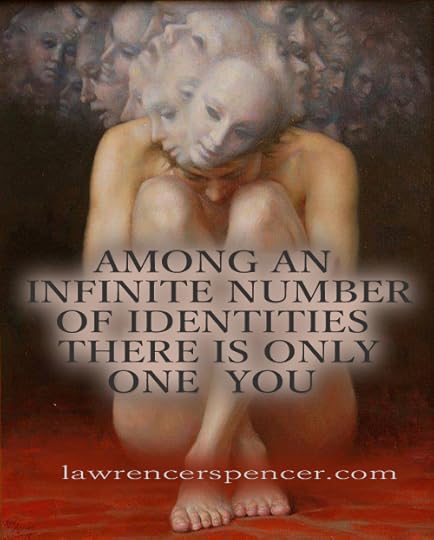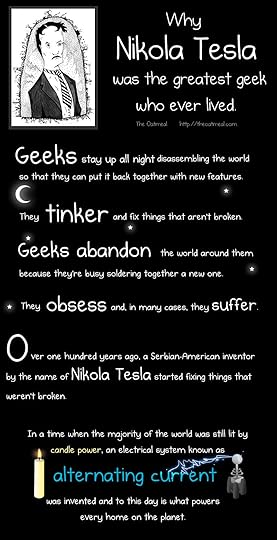Lawrence R. Spencer's Blog, page 504
November 25, 2014
ALIEN INTERVIEW – INTRO LECTURE by LAWRENCE SPENCER on DVD
November 24, 2014
RELIGIOUS HARMONY
One of the most amazing feats of monumental building are the Ellora Caves. The construction of this site is attributed to 3 religious factions, all of which originated with the teaching passed down for 10,000 years through the Veda. Could these massive rock carving and sculptures be duplicated with "modern" technology? Would current "civilization" allow this work to be done?
Ellora Caves is an archaeological site, 29 km (18 mi) North-West of the city of Aurangabad in the Indian state of Maharashtra built by the Rashtrakuta dynasty. It is also known as Elapura (in the Rashtrakuta literature-Kannada). Ellora represents the epitome of Indian rock-cut architecture. The 34 "caves" are actually structures excavated out of the vertical face of the Charanandri hills. Buddhist, Hindu and Jain rock-cut temples and viharas and mathas were built between the 5th century and 10th century. The 12 Buddhist (caves 1–12), 17 Hindu (caves 13–29) and 5 Jain (caves 30–34) caves, built in proximity, demonstrate the religious harmony prevalent during this period of Indian history. -- (Wikipedia.org)\
VISIT THESE WEBSITES TO SEE A COMPLETE PHOTO ALBUM OF THE ELORA CAVES:
http://www.loupiote.com/sets/72157621310793836.shtml
http://www.loupiote.com/photos/3711011275.shtml?&s=72157621310793836
November 23, 2014
ECHOES OF LOVE
ONLY ONE YOU
November 21, 2014
ENTANGELMENTS OF THE TWIN FLAME POLARITY SELF
"Twin Flame / Polarity Self": A Manifestation of “Entanglement” in Quantum Physics --- by Lawrence R. Spencer
--- by Lawrence R. Spencer
DEFINITION: “polarity” = noun: having an indicated pole (as the distinction between positive and negative electric charges)
A “Twin Flame Polarity Self” is the description of a relationship between two Immortal Spiritual Beings (Is-Bes) who each manifest the opposite, and complimentary, "polarity" (positive / negative energy) of the same spiritual "self". The ancient principle of Ying / Yang is a common interpretation of this phenomenon from the prehistory on Earth.
Theoretically, one Is-Be possesses only ONE HALF of the total energetic ability of the combined Is-Be. When the “halves” of the “whole” Is-Be are separated they do not have the same Power and Ability they have when they are together!
The New Age “Law of Attraction” is based primarily on the observation and experience of this phenomenon. In human experience it is most often an interaction between people, especially lovers or life partners. It is common for people to search for their “true love” or “soul mate”, with a primordial, insatiable yearning that is fulfilled by only a few in one lifetime, if ever. However, when one finds and is “reunited” with their “Twin Flame” the resulting relationship is nothing less than profoundly fulfilling, gratifying and transcendent for each person!
The entire physical universe seems to be constructed of “Thought Energy”. By experiment and common observation, the “energy” in our physical universe is ALWAYS composed of a “polarity”, i.e. positive + negative (male + female) energy.
Nikola Tesla observed that “If you want to find the secrets of the universe, think in terms of energy, frequency and vibration.” And, “The day science begins to study non-physical phenomena, it will make more progress in one decade than in all the previous centuries of its existence.” . He was the first person to observe that an electric motor cannot run without BOTH positive and negative electrons. It will not generate power. Nickola Tesla discovered that the most powerful electric generators are created using "alternating current". This is a flow of electricity that COMBINES POSITIVE and NEGATIVE electrons through a simultaneous and alternating INTERACTION which flows along the SAME PATH at the SAME TIME. His invention of the Alternating Current Generator changed the entire history of Earth by bringing electricity to the entire planet!
This "polarity" phenomenon is not only a personal, subjective, spiritual or romantic reality, but a scientific fact. In recent years proof of this reality has been proven by experiment by quantum physicists. It is called “Entanglement”.
The following article explains "Entanglement" in Quantum Physics:
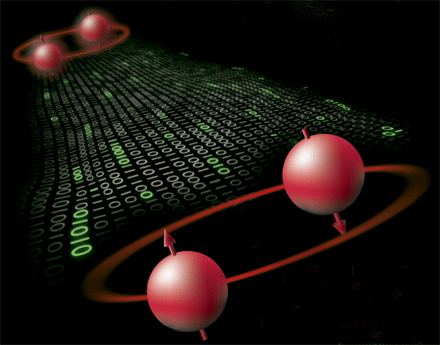 “Identical twins, it's said, can sometimes sense when one of the pair is in danger, even if they're oceans apart. Tales of telepathy abound. Scientists cast a skeptical eye over such claims, largely because it isn't clear how these weird connections could possibly work. Yet they've had to come to terms with something that's no less strange in the world of physics: an instantaneous link between particles that remains strong, secure, and undiluted no matter how far apart the particles may be – even if they're on opposite sides of the universe. It's a link that Einstein went to his grave denying, yet its existence is now beyond dispute. This quantum equivalent of telepathy is demonstrated daily in laboratories around the world. It holds the key to future hyperspeed computing and underpins the science of teleportation. Its name is "entanglement".
“Identical twins, it's said, can sometimes sense when one of the pair is in danger, even if they're oceans apart. Tales of telepathy abound. Scientists cast a skeptical eye over such claims, largely because it isn't clear how these weird connections could possibly work. Yet they've had to come to terms with something that's no less strange in the world of physics: an instantaneous link between particles that remains strong, secure, and undiluted no matter how far apart the particles may be – even if they're on opposite sides of the universe. It's a link that Einstein went to his grave denying, yet its existence is now beyond dispute. This quantum equivalent of telepathy is demonstrated daily in laboratories around the world. It holds the key to future hyperspeed computing and underpins the science of teleportation. Its name is "entanglement".
The concept, but not the name of entanglement, was first put under the scientific spotlight on May 15, 1935, when a paper by Einstein and two younger associates, Nathen Rosen and Boris Podolosky, appeared in the journal Physical Review. Its title – "Can a Quantum-Mechanical Description of Physical Reality Be Considered Complete?" – leaves no doubt that the paper was a challenged to Niels Bohr and his vision of the subatomic world. On June 7, Erwin Schrödinger, himself no lover of quantum weirdness, wrote to Einstein, congratulating him on the paper and using in his letter the word entanglement – or, rather, its German equivalent verschränkung – for the first time. This new term soon found its way into print in an article – sent to the Cambridge Philosophical Society on August 14 that was published a couple of months later. In it he wrote:
When two systems ... enter into temporary physical interaction ... and when after a time of mutual influence the systems separate again, then they can no longer be described in the same way as before, viz. by endowing each of them with a representative of its own. I would not call that one but rather the characteristic trait of quantum mechanics, the one that enforces its entire departure from classical lines of thought. By the interaction the two representatives [the quantum states] have become entangled.
The characteristic trait of quantum mechanics ... the one that enforces its entire departure from classical lines of thought – here was an early sign of the importance attached to this remarkable effect. Entanglement lay at the very heart of quantum reality – its most startling and defining feature. And Einstein would have none of it. Yet, the fact of the existence of the “entanglement” phenomenon in this universe have now been conclusively proven by numerous experiments.
Practical applications
The phenomenon of entanglement has already begun to be exploited for practical purposes. In the late 1980s, theoreticians started to see entanglement not just as a puzzle and a way to penetrate more deeply into the mysteries of the quantum world, but also as a resource. Entanglement could be exploited to yield new forms of communication and computing. It was a vital missing link between quantum mechanics and another field of explosive growth: information theory. The proof of nonlocality and the quickly evolving ability to work with entangled particles in the laboratory were important factors in the birth of a new science. Out of the union of quantum mechanics and information theory sprang quantum information science – the fast-developing field whose most important fields of development are quantum cryptography, quantum teleportation, and quantum computers.”
READ THE ENTIRE ARTICLE: http://www.daviddarling.info/encyclopedia/Q/quantum_entanglement.html
November 19, 2014
SPARK OF THOUGHT
I personally recommend that every serious student of Life, Universes and Other Stuff, read the autobiography of Nikola Tesla, titled, "MY INVENTIONS". Serbian inventor NIKOLA TESLA (1857-1943) was a revolutionary scientist who forever changed the scientific fields of electricity and magnetism. Tesla's greatest invention, A/C current, powers almost all of the technological wonders in the world today, from home heating to computers to high-tech robotics. His discoveries gave mankind the television. And his dream of wireless communication came to pass in both the radio and eventually the cell phone. Yet his story remains widely unknown.

Tesla with one of his famous "wireless" lamps. Published on the cover of the Electrical Experimenter in 1919.
Few inventors contributed more to advances in science and engineering in the early 20th century than Nikola Tesla. As one of the Fathers of Electricity, Tesla did groundbreaking work on alternating current (AC) power system, electromagnetism, hydroelectric power, radio, and radar to name a few. Many of his inventions (Tesla obtained some 300 patents in his lifetime) became the stuff we take for granted today: when we flip a switch to turn on the light, we owe a lot of that electrical magic to Tesla.
As fate would have it, Tesla, one of the world's greatest inventors, died penniless and in obscurity. Even today, many people mistakenly attribute many of his inventions to others (Edison, for example, is in the name of many power companies in the United States - ironically, they use the AC system devised by Tesla rather than the more inefficient direct current or DC system espoused by Thomas Edison; Tesla also invented the fundamentals of radio transmissions before Gugliegmo Marconi).
Today, there's quite a bit of resurgence in Tesla's popularity, which is helped in part by his mystique as a "mad scientist." Amongst his more outlandish ideas, Tesla worked on death rays to knock out enemy airplanes out of the skies, pocket-sized resonance machine that could topple buildings, ways to send electricity through the upper atmosphere, force-fields to protect cities, and so on.

Tesla Company letterhead. Note the words "World Wireless Telephone Transmitter."
In their book, Tesla: Master of Lightning , authors Margaret Cheney and Robert Uth tell the story of the enigmatic genius from his birth in a little village in what is Croatia today, to his lonely death in a New York hotel room. The book, years in the making, combines archival documents and hundreds of photographs, compiled from the Tesla Museum in Belgrade (previously inaccessible to Western writers during much of the Cold War era), excerpts from Tesla's writings, as well as interviews with people who knew the man personally, to paint detailed snapshots of Tesla's life and to provide clear explanations of his (often very technical) work.
, authors Margaret Cheney and Robert Uth tell the story of the enigmatic genius from his birth in a little village in what is Croatia today, to his lonely death in a New York hotel room. The book, years in the making, combines archival documents and hundreds of photographs, compiled from the Tesla Museum in Belgrade (previously inaccessible to Western writers during much of the Cold War era), excerpts from Tesla's writings, as well as interviews with people who knew the man personally, to paint detailed snapshots of Tesla's life and to provide clear explanations of his (often very technical) work.
On a personal note, it has taken me far longer than I expected to write this excerpt for Neatorama Spotlight. Margaret and Robert's book was so fascinating that on many nights, I ended up reading late pass my bedtime. It seems like on every single page there were neat details about Tesla that were just too good not to share! I highly recommend Tesla: Master of Lightning to anyone interested in learning more about the legendary Nikola Tesla.
to anyone interested in learning more about the legendary Nikola Tesla.
Excerpts from Tesla: Master of Lightning, by Margaret Cheney and Robert Uth:

An Old World Childhood
As a youth, Tesla exhibited a peculiar trait that he considered the basis
of all his invention. He had an abnormal ability, usually involuntary,
to visualize scenes, people, and things so vividly that he was sometimes
unsure of what was real and what imaginary. Strong flashes of light often
accompanied these images. Tormented, he would move his hand in front of
his eyes to determine whether the objects were simply in his mind or outside.
He considered the strange ability an affliction at first, but for an inventor
it could be a gift.
Tesla wrote of these phenomena and of his efforts to find an explanation
for them, since no psychologist or physiologist was ever able to help
him. "The theory I have formulated," he wrote much later, is
that the images were the result of a reflex action from the brain on the
retina under great excitation. They certainly were not hallucinations,
for in other respects I was normal and composed. To give an idea of my
distress, suppose that I had witnessed a funeral or some such nerve-wracking
spectacle. Then, inevitably, in the stillness of the night, a vivid picture
of the scene would thrust itself before my eyes and persist despite all
my efforts to banish it. Sometimes it would even remain fixed in space
though I pushed my hand through it. (Tesla, My inventions: My early life.
Electrical Experimenter; February 1919)

Tesla in his Houston Street laboratory. Caption for this photo in Electrical
Review, March 29, 1899 reads: "The operator's body, in this
experiment, is charged to a high potential by means of a coil responsive
to the waves transmitted to it from a distant oscillator."
Geniuses Collide
On the summer day in 1884 when Tesla, carefully dressed in his bowler
hat, striped trousers, and cut-away coat (the whole of his wardrobe),
dropped in to see the famous Mr. Edison, there had been an emergency at
the Vanderbilt mansion on Fifth Avenue. Two wires had shorted behind a
metallic-threaded wall hanging and started a fire. Mrs. Vanderbilt herself
had smothered the flames, only to learn that the problem emanated from
a steam engine and boiler in her basement. Now the angry socialite was
demanding that Edison remove the whole apparatus. No sooner had he rushed
back to Pearl Street than the manager of a shipping firm called to remind
him that the SS Oregon had been tied up for days awaiting electrical
repairs and was losing money by the hour. Unfortunately Edison had no
more engineers to assign to the job.
At this juncture he became aware of the tall foreign gentleman hovering
politely in the doorway, bowler hat in gloved hand, a letter in his pocket
from Charles Batchelor, the English engineer who managed the Continental
Edison Company in Europe. Few American colleges then trained electrical
engineers, so prospects were good for the rare immigrant who was qualified.
But Mr. Edison was not in a congenial mood.
Tesla spoke up, knowing the famous man had a had a hearing problem, and
introduced himself. He produced the brief message from Batchelor. Edison
glanced at the few lines and snorted. "I know two great men and you
are one of them," Batchelor had written. "The other is this
young man!"
Thomas Edison, rumpled, weary, and deeply skeptical, asked Tesla what
he could do. While the American inventor was only eight years older than
his visitor, and lacked his formal education, he was already world-renowned
for his inventions. Tesla recalled their meeting:
When I saw this wonderful man, who had had no training at all, no advantages,
and who did it all himself, and saw the great results by virtue of his
industry and application - you see, I had studied a dozen languages
... and had spent the best years of my life ruminating through libraries.
I thought to myself what a terrible thing it was to have wasted my life
on those useless things, and if I had only come to America right then
and there and devoted all of my brain power and inventiveness to my
work, what could I not have done? (Tesla, My inventions: My early life.
Electrical Experimenter; February 1919)
In awe of Edison, Tesla proceeded to describe the engineering work he
had done in France and Germany, and spoke of his plans for induction motors
made to run smoothly and powerfully on alternating current. That invention,
he reckoned, was worth many fortunes.
Edison knew little of alternating current, chose to believe it the work
of the devil, and did not care to learn more about it. Did this dandified
"Parisian" realize that was he was suggesting could make a whole
industry obsolete? In the past Edison had waged a propaganda war against
the gas companies on the grounds that the possibility of explosions made
gas too dangerous for human use as a power source. He was therefore experienced
in recognizing and heading off any threat of industrial competition.
Tesla, unprepared for the force of Edison's passion, thanked him and
turned to leave. As he did so a breathless boy rushed into the plant to
report that a junction box at Pearl and Nassau streets was leaking electricity
and had injured a carter and his horse. Edison bellowed at his foreman.
Then he turned to Tesla and said, "Hold up a minute, Mister. Can
you fix a ship's lighting plant?"
So began this historic collision of geniuses. Eventually it would spark
the bitter and long-running "War of the Currents," the taste
of which still lingers today in corporate memories.

Laboratory where TEsla and Westinghouse engineers developed apparatus
for AC systems.
Tesla's exhibit with his "Egg of Columbus," which stood on end
when the table it rested on was magnetically excited by AC.
Another smaller table with ball can be seen to the left; to the right,
an early high-frequency machine.
The Executioner's Current
It is strange but true that the introduction of the electric chair in
America came purely out of a commercial battle over light bulb sales.
Or, more accurately, over what kind of power supply would energize the
nation's early lighting. Orders to Edison's lighting companies had fallen
behind those for Westinghouse's newer AC systems. With progress marching
right past him, Edison and his Wall Street investors opened a delaying
campaign to block AC systems in any way possible, the DC interests took
up the idea that AC would fail if it was perceived as deadly. One shadowy
figure associated with Edison, Harold P. Brown, became a very public advocate
of "humane" death - to be inflicted on animals or humans - by
AC electricity. Brown electrocuted dogs and horses under questionable
experimental conditions. After Edison provided him with research facilities
at his West Orange, New Jersey, laboratory, neighbors began to complain
of disappearing household pets.
Brown's efforts inspired New York State prison officials to try the idea
on a human being. A law was passed in New York (1887) to abandon hanging
in favor of electrocution as of January 1, 1889.
Brown, predictably, had a hand in providing apparatus to the state -
a 2,000-volt Westinghouse alternator purchased secondhand - since Westinghouse
refused to sell when approached. First to die by the newly prescribed
capital punishment was William Kemmler, convicted of killing his wife.
He was executed at the Auburn Prison, August 6, 1890. Several jolts were
delivered, one for seventeen seconds and another for three and a half
minutes. Witnesses reported that the victim's spinal cord burst into flames.
The method hasn't worked very predictably, even up to today.
A number of terms were suggested for this new method of execution, including
"thanelectrize," "electrophon," "electroctasy,"
"electrotony," and "fulmenvoltacuss." And why "electrocute,"
also on the list, should have come to be preferred over the straightforward
"electrocize" is anyone's guess. The vested interest in DC current,
however, made a point of saying victims of electric shocks had been "Westinghoused."

Tesla in a thoughtful pose in front of his "web" coil, May 1896.
Lionized and Ionized

(L) Mark Twain and Joseph ("Jo") Jefferson in Tesla's South
Fifth Avenue laboratory, 1894, with blurred image of TEsla between.
(R) Mark Twain in Tesla's laboratory at 35 South Fifth Avenue, early 1895
Perhaps Tesla's most famous friend was the writer Mark Twain, with whom
the Serb's literary connections went back to childhood. In his autobiography,
Tesla described how Twain helped him recover from a dangerous illness
when he was brought the early novels from his local public library and
found them "so captivating as to make me utterly forget my hopeless
state." He attributed the miraculous recovery that followed to the
humorist. Tesla claims that twenty-five years later, when he met Twain
in New York, he told him the touching story "and was amazed to see
that great man of laughter burst into tears" (Tesla, My inventions:
My later endeavors. Electrical Experimenter; 1919)
In Mark Twain's Notebooks & Journals, the author mentions
reading about the sale to Westinghouse of Tesla's electrical patents,
"which will revolutionize the whole electric business of the world."
Twain had made a bad investment - one of many - in the development of
a new DC motor, and was drawn to Tesla for answers. The answer was that
this motor had been rendered obsolete by Tesla's polyphase AC. Because
this appears to have been the occasion for their first meeting, Twain's
tears may have had a more pecuniary cause.
On that basis, the two men became lifelong friends and, incidentally,
fellow members of the posh Players Club. Twain later was instrumental
in encouraging Tesla to pursue his futuristic weapons for shifting war's
destructiveness from men to machines, it then being innocently thought
that wars would cease when weapons became too horrible to contemplate.
Mark Twain was one of the friends most often invited to Tesla's laboratory
for the improvisational shows of fright and delight. On one particular
evening Twain himself inadvertently furnished the entertainment when he
insisted upon experiencing the gyrations of a platform mounted on an electrical
oscillator. Tesla pretended to dissuade him, which of course made Twain
all the more desirous of prolonging the test. Once on the machine he kept
saying, "More, Tesla, more!" But soon he was crying for help,
since an undesired effect of the oscillations on the human body was to
create a turmoil in the bowels.
When he was next invited to the laboratory, a wiser Twain wrote: "Friday,
Midnight. Dear Mr. Tesla: I am desperately sorry, but a matter of unavoidable
business has intruded itself and bars me from coming down ... I am very,
very sorry. Do forgive me." (Twain n.d.).
Colorado Springs

This publicity photo taken at Colorado Springs was a double exposure.
Tesla poses with his "magnifying transmitter" capable of producing
millions of volts of electricity. The discharge here is twenty-two feet
in length.
In a patent filed the previous year, "System of Transmission of
Electrical Energy" (number 645,576), [Tesla] claimed "it has
become possible to transmit through even moderately rarefied strata of
atmosphere electrical energy to practically any amount and to any distance."
[...] A friend and patent lawyer, Leonard E. Curtis, on being advised
of Tesla's scheme, offered to find land and provide power for his research
from the El Paso Power Company of Colorado Springs [...]
The laboratory that began to rise from the prairie floor was both wired
and weird, a contraption with a roof that rolled back to prevent it from
catching fire, and a wooden tower that soared up to eighty feet. Above
it was a 142-foot metal mast supporting a large copper ball. Inside the
strange wooden structure, technicians began to assemble an enormous Tesla
coil. The frame on which the heavy primary and 17-turn secondary coils
were wound had a diameter of fifty-one feet. The third coil within it
was eight feet in diameter, with a hundred turns of wire. This enormous
air-core transformer could deliver a current of 1,100 amperes. The mysterious
"extra coil" in the center magnified the electrical effects
through a process called "resonant rise." The function of this
coil was not understood until the 1970s.
Builders erected a high fence around the site, and signs appeared on
every post - KEEP OUT. GREAT DANGER - in hopes of keeping the curious
at a distance. Fritz Löwenstein could not resist posting at the door
another sign, quoting Dante's Inferno: "Abandon hope, all
ye who enter here." [...]

Caption in Century Magazine, June 1900, reads: "The photograph
shows three ordinary incandescent lamps lighted to full candle-power by
currents induced in a local loop consisting of a single wire forming a
square of fifty feet each side, which includes the lamps, and which is
at a distance of one hundred feet from the primary circuit energized by
the oscillator."
To test his theory, Tesla had to become the first man to make electrical
effects on the scale of lightning. The giant transmitter was arranged
accordingly. On the evening of the experiment, he dressed for the occasion
in a Prince Albert coat, white gloves, and a derby hat. To avoid electrocution,
he took the precaution of wearing shoes with four-inch cork soles. One
of his assistants described him as looking like a "gaunt Mephistopheles."
Each item of equipment, every wire and connection, had been carefully
checked. Tesla instructed his mechanic, Czito, to open the switch for
only one second. The secondary coil began to sparkle and crack and an
eerie blue corona formed in the air around it. Satisfied with the result,
he ordered Czito to close the switch until told to cease. Huge arcs of
blue electricity snaked up and down the center coil. Exploding discharges
could be heard outside (Cheney, Margaret. 1981. Tesla: Man Out of Time.
New York: Prentice-Hall. Reprint, 1991. New York: Barnes & Noble Books)
Bolts of man-made lightning more than a hundred feet in length shot out
from the mast atop the station. The commotion could be heard in the mining
town of Cripple Creek, fifteen miles away. Tesla thrilled to the sight
of great rods of flame. Then suddenly the lightning stopped. The experimental
station went black. He shouted to Czito to turn the power on again, but
nothing happened. His experiment had burned out the dynamo at the El Paso
Electric Company. Not only Tesla, but the entire city had lost power.
The power station manager was livid and the local population began to
have second thoughts about the famous inventor. But a week after the blackout,
both Tesla and the power station were back in business. However, Tesla
received no more free power.
A Weapon to End War

(L) Postcard illustration of the Hotel New Yorker, New York City. (Collection
of The New-York Historical Society)
(R) Tesla announced his new beam weapon in numerous newspaper interviews
on his seventy-eighth birthday.
This article is from The New York Times, July 11, 1934.
In 1934 Tesla moved to his final residence, room 3327 (still divisible
by three) of the recently completed Hotel New Yorker. There he lived alone
with his ideas and his pigeons for the next decade. He posted a typewritten
note on the door: "Please Do Not Disturb The Occupant Of This Room."
In Tesla's mind, it was time to reveal his greatest invention: a perfect
and impossible idea, a weapon to prevent World War II.
On July 11, 1934, the headline on the front page of the New York
Times screamed, "TESLA AT 78 BARES NEW DEATH-BEAM." The
invention, the article reported,
will send concentrated beams of particles through the free air, of
such tremendous energy that they will bring down a fleet of 10,000 enemy
airplanes at a distance of 250 miles from a defending nation's border
and will cause armies of millions to drop dead in their tracks.
When put in operation, Dr. Tesla said, this latest invention of his
would make war impossible. This death-beam, he asserted would surround
each country like an invisible Chinese wall, only a million times more
impenetrable. It would make every nation impregnable against attack
by airplanes or by large invading armies. [...]
Joseph Butler, a U.S. Air Force expert on beam weapons, has said of Tesla's
idea, "Definitely, he had the concept of a charged particle beam
weapon back in the 1930s. The concept was right on the mark ... particles
projected out long distances to do damage to some enemy airplanes, in
his particular case." But Butler added, "I haven't a clue how
he meant to actually do it" (interview with the authors, 1998).

Tesla's system of transmission of power to aircraft by radio. Illustrated
by Frank Paul for Radio News, December 1925.
Enigmatic to the End
Tesla's friend Kenneth Swezey also visited and was equally alarmed by
his condition, particularly when he saw that Tesla was subsisting on warm
milk and Nabisco crackers. He noted that the empty enameled cracker cans
were stacked on shelves and used to hold various things. Word began to
spread that the great inventor was near death.
Late in December of 1942, with the war at its height, two young men identifying
themselves as U.S. government agents suddenly entered Tesla's life. One
was a member of the OSS (predecessor to the CIA) named Ralph Bergstresser.
The other, Bloyce Fitzgerald, was an expert on ballistics technology working
with the Massachusetts Institute of Technology. According to Bergstresser,
Tesla agreed to share his most sensitive documents with them and allowed
them to carry stacks of material away for microfilming. Based on their
review, the two men were able to arrange a meeting at the White House
on January 8, 1943, with Roosevelt's science advisor and other high-ranking
officials. Tesla was too ill to attend (interview with the authors, 1993).
Meanwhile a prominent Yugoslav writer, Louis Adamic (The Immigrant's
Return), wrote a letter to Eleanor Roosevelt on December 29 describing
the inventor's circumstances:
Today he is ... worse than penniless. He is extremely frail, weighing
less than 90 pounds. His health is poor; he has grown somewhat bitter
against his country, the United States ... He suffers, too, to the point
of bitterness, because he feels that everyone in America, including
beneficiaries of fortunes created by his inventions, has forgotten him.
... The fact now is that he is up against it ... This letter is not
an appeal to help him financially. ... This is merely to suggest that
the President write him a letter which will indicate that America has
not forgotten [him]. Perhaps this coming New Year is a good occasion
for such a letter (Adamic 1942).
New Year's Eve came and went, and there was no letter. Tesla's loyal
associate, George Scherff, visited him on January 4 to help him prepare
for an experiment. The final project, its nature unknown, was terminated
when Tesla complained of sharp pains in his chest. He refused medical
aid. Scherff left the hotel, bidding him goodbye for the last time.

On the night of January 7, 1943, the eve of the Orthodox Christmas, snow
fell on New York City. In a darkened room on the thirty-third floor of
the Hotel New Yorker, Tesla lay listening to the clamor of traffic below.
His great legacy, the technological world he had helped create, would
continue without him. There would be no more riveting announcements, or
shrieks of "Eureka," or terrifying bolts of lightning leaping
in his laboratory. The pigeons on the window ledge stirred their feet
and ruffled their feathers. Hard times lay ahead for the pigeons; he had
nothing to leave them.
Nikola Tesla, aged eighty-six, died in his sleep. The coroner's report
read: "No suspicious circumstances."
The Cosmic Signature

Nikola Tesla monument installed at Goat Island, Niagara Falls, a gift
to the United States on the occasion of its bicentennial and Tesla's 120th
anniversary, July 23, 1976. The monument is a second casting of the sculpture
by Fran Krsinic.
The first casting is installed in front of the Faculty of Electrical Engineering
Building, University of Belgrade.
The world would be a very different place without the ideas and inventions
of Nikola Tesla. With the flick of a switch the power of the waterfall
and the coal furnace is transported to our fingertips. Worldwide communication
reach nearly every person on the planet. A remote-controlled device has
explored the surface of Mars. And at this moment, receivers are pointed
at the heavens waiting for a message from afar. One can picture the inventor
nodding, then shrugging, and perhaps wondering what took us so long. In
the end, Tesla was one of our greatest dreamers, and great dreams have
a way of becoming reality. The inventor consoled himself by saying, "The
scientific man does not aim at an immediate result. He does not expect
that his advanced ideas will be readily taken up. His work is like that
of a planter - for the future. His duty is to lay the foundation for those
who are to come, and point the way. (Tesla, My inventions: My early life.
Electrical Experimenter; February 191
GREATEST GEEK
THIS IS THE FIRST PAGE OF A VERY EXCELLENT ON-LINE "COMIC BOOK" ABOUT NIKOLA TESLA. READ THE ENTIRE THING HERE: Why Nikola Tesla was the greatest geek who ever lived - The Oatmeal
Additional notes from the author:
If you want to learn more about Tesla, I highly recommend reading Tesla: Man Out of Time
Also, this Badass of the week by Ben Thompson is what originally inspired me to write a comic about Tesla. Ben's also got a book out which is packed full of awesome.
There's an old movie from the 80s on Netflix Instant Queue right now about Tesla: The Secret of Nikola Tesla. It's corny and full of bad acting, but it paints a fairly accurate depiction of his life.
The drunk history of Tesla is quite awesome, too.
X-rays: just to clarify, Tesla did not discover x-rays, but he was one of the early pioneers in its research.
Cryogenic engineering: I'm referring to the cryogenic engineering that has to do with using liquified air to cool a coil and reduce its electrical resistance (Patent No. 11,865), not freezing people and waking them up in the future so they can fight Wesley Snipes.
Transistor: Tesla's influence on the modern transistor can be found in patents 723,188 and 725,605. (a better explanation here)
Radio: Tesla was the nicest geek ever until he decided to sue Marconi a few years later. 8 months after Tesla died, the U.S. Supreme Court overturned Marconi's patents on the invention of radio. So Tesla eventually won that battle, although he was dead by then.
Tesla VS Edison: I could write a novel on the differences between Tesla and Edison, but seeing as how this comic is already huge I decided to leave many things out. For instance, Edison killed cats and dogs, but Tesla loved animals and had a cat as a child. Originally Tesla wanted to be a poet, but after getting zapped by static electricity from his kitty he was inspired to study the effects of electricity. One could vaguely construe that Tesla's cat was responsible for the second industrial revolution, which arguably makes it the most awesome cat who ever lived.
Edison believed that fossil fuels were the future and that there were enough resources in South America to provide for the next 50,000 years. Tesla believed that renewable energy sources like hydroelectric, solar, and wind power were the future. This is remarkable because in the 1890s there was no such thing as "going green," so Tesla's ideas on conservation were very forward-thinking at the time. (From OATMEAL)
November 16, 2014
FINANCIAL REPORT: THE 7 FIGURE INCOME
$10,000.29 (technically know as 5 figures...).
SOURCE: http://www.gallup.com/poll/166211/worldwide-median-household-income-000.aspx
TEN+ FIGURE INCOMES : A List of Billionaires--- NOTE: the Elite Banking Families (Rothschild, Rockefeller, etc.) are not listed here as their wealth is virtually unlimited. When you PRINT MONEY you never run out of it!
Rank
Country / Region
Number of billionaires
Richest of the Country / Region
1 United States
United States
492
Bill Gates
2 China
China
152
Wang Jianlin
3 Russia
Russia
111
Alisher Usmanov
4 India
India
100
Mukesh Ambani [1]
5 Germany
Germany
85
Dieter Schwarz
6 Brazil
Brazil
65
Jorge Paulo Lemann
7 United Kingdom
United Kingdom
47
Gerald Cavendish Grosvenor and family
8 Hong Kong
Hong Kong
45
Li Ka-shing
9 France
France
43
Liliane Bettencourt and family
10 Italy
Italy
35
Michele Ferrero and family
11 Canada
Canada
32
David Thomson and family
12 Australia
Australia
29
Gina Rinehart
13 Taiwan
Taiwan
28
Tsai Eng-Meng
14 Japan
Japan
27
Masayoshi Son
14 South Korea
South Korea
27
Lee Kun-Hee
16 Spain
Spain
26
Amancio Ortega
17 Turkey
Turkey
24
Murat Ülker
18 Switzerland
Switzerland
21
Ernesto Bertarelli and family
19 Indonesia
Indonesia
19
R. Budi Hartono
19 Sweden
Sweden
19
Stefan Persson
21 Israel
Israel
18
Eyal Ofer
22 Mexico
Mexico
16
Carlos Slim Helu and family
22 Singapore
Singapore
16
Robert Ng and Philip Ng
24 Malaysia
Malaysia
13
Robert Kuok
25 Chile
Chile
12
Iris Fontbona and family
26 Thailand
Thailand
11
Dhanin Chearavanont and family
27 Austria
Austria
10
Dietrich Mateschitz
27 Philippines
Philippines
10
Henry Sy and family
Rest of the World
156
Aliko Dangote, Nigeria
Total
1,645
Bill Gates
November 15, 2014
J.P. MORGAN — TITANIC CRIMINAL
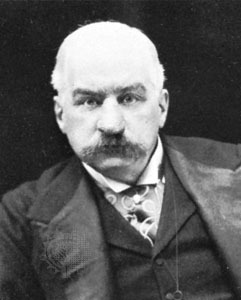 THE SINKING OF THE TITANIC (OWNED BY J.P. MORGAN) WAS THE TIP OF THE ICEBERG. THE TITANIC SINKING PULLED OFF 4 OF THE GREATEST CRIMINAL PLOTS IN HISTORY -- ALL AT THE SAME TIME!
THE SINKING OF THE TITANIC (OWNED BY J.P. MORGAN) WAS THE TIP OF THE ICEBERG. THE TITANIC SINKING PULLED OFF 4 OF THE GREATEST CRIMINAL PLOTS IN HISTORY -- ALL AT THE SAME TIME!1) HE MURDERED ALL OF HIS BUSINESS COMPETITION AT ONCE -- 3 of the 4 WEALTHIEST MEN IN THE WORLD -- ALL OF WHOM OPPOSED THE FEDERAL RESERVE ACT THAT WOULD GIVE MORGAN CONTROL OF THE ENTIRE MONEY SUPPLY OF THE UNITED STATES.
2) SQUASHED THE INVENTION OF "FREE ENERGY" BY NIKOLA TESLA ENSURING PRIVATE CONTROL OF ENERGY REVENUE FOREVER, i.e. oil, coal, gas, electricity, etc..
3) GUARANTEED THE PASSAGE OF THE "FEDERAL RESERVE ACT" TO ESTABLISH HIS PRIVATE BANK AND CONTROL ALL OF THE GOLD, MONEY SUPPLY AND PROPERTY OF THE UNITED STATES.
4) SAVED HIS 'WHITE STAR' SHIP LINE FROM BANKRUPTCY BY COLLECTING A FRAUDULENT INSURANCE PAYMENT ON THE TITANIC.
PHOTO RIGHT -- 1st Row: JP Morgan, Joseph Bruce Ismay, John Jacob Astor and Benjamin Guggenheim. 2nd Row: The Federal Reserve and the TitanicAs youngsters, we're all told the infamous story of the Titanic, the supposedly indestructible ship that sunk on its maiden voyage. We're all familiar with the story: the ship left Southampton, England, headed for New York City on April 10, 1912.

Four days into the voyage, at 11:40pm on April 14, 1912, the Titanic struck an iceberg and sank at 2:20am, "resulting in the deaths of 1,517 people in one of the deadliest peacetime maritime disasters in history [12]."
Bad luck, we're all led to believe. No one saw the iceberg and so the infallible ship sank. Bummer...
But few of us ever think that through. Forget, for a moment, the story we're all fed. Does it make sense? My point is that just because we're told a story when we're young, doesn't mean we should simply accept it as absolute truth.
Let's take a look at some of the facts surrounding the sinking of the Titanic:
As youngsters, we're all told the infamous story of the Titanic, the supposedly indestructible ship that sunk on its maiden voyage. We're all familiar with the story: the ship left Southampton, England, headed for New York City on April 10, 1912. Four days into the voyage, at 11:40pm on April 14, 1912, the Titanic struck an iceberg and sank at 2:20am, "resulting in the deaths of 1,517 people in one of the deadliest peacetime maritime disasters in history [12]."
Bad luck, we're all led to believe. No one saw the iceberg and so the infallible ship sank. Bummer...
But few of us ever think that through. Forget, for a moment, the story we're all fed. Does it make sense? My point is that just because we're told a story when we're young, doesn't mean we should simply accept it as absolute truth.
Let's take a look at some of the facts surrounding the sinking of the Titanic:
1. The unsinkable Titanic sunk...on its maiden voyage. How could this unsinkable ship sink? On its first trip, no less! That alone is quite remarkable/intriguing.
2. "Captain E.J. Smith ignored multiple iceberg warnings from his crew and other ships." Getting from England to New York as fast as possible was goal number one, at the behest of his boss, Joseph Bruce Ismay, Managing Director of the White Star Line. Ismay had pressure from his boss, J.P. Morgan, owner of White Star Line [3]. By the way, Ismay survived the catastrophe.
3. Speaking of J.P. Morgan, he had his very own private suite and promenade deck on the Titanic. He was supposed to be on that fateful maiden voyage but canceled passage [8]. Coincidence or part of Morgan's plan?
4. Once the Titanic struck the iceberg, the captain and his crew used white flares to signal distress. Unfortunately,white flares are not the color used to signal distress; red flares are always used to show distress. So the closest ship, the Californian, ignored the flares, assuming it was a celebratory signal, rather than an emergency [7]. Oops...
5. "All ships must carry sufficient lifeboats for the number of passengers on board. The Titanic did not [7]."
6. "About three million rivets were used to hold the sections of the Titanic together. Some rivets have been recovered from the wreck and analysed. The findings show that they were made of sub-standard iron. When the ship hit the iceberg, the force of the impact caused the heads of the rivets to break and the sections of the Titanic to come apart. If quality iron rivets had been used, the ship may not have sunk [7]."
7. "The belief that the ship was unsinkable was, in part, due to the fact that the Titanic had sixteen watertight compartments. However, the compartments did not reach as high as they should have. White Star Line did not want them to go all the way up because this would have reduced living space in first class [7]."
8. Killed on the sinking ship -- along with 1,514 other people -- were Benjamin Guggenheim, Isa Strauss and John Jacob Astor. Astor was, at the time, believed to be the wealthiest man on the planet. Guggenheim and Strauss weren't far behind Astor. And these three powerful men opposed the Federal Reserve.
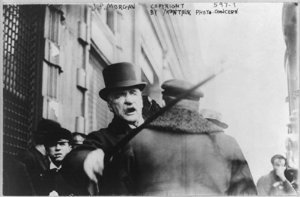 (PHOTO LEFT) An angry JP Morgan yelling at photographers. He hated having his picture taken.As an aside to the above facts, let's take a look at an additional dimension to the dynamic between J.P. Morgan and John Jacob Astor. Both Morgan and Astor invested large sums of money in the brilliance of Nikola Tesla, a genius inventor who gained notoriety during the late 19th/early 20th century. Morgan's primary concern with Tesla was making money. Astor and Tesla, however, were good friends [9].
(PHOTO LEFT) An angry JP Morgan yelling at photographers. He hated having his picture taken.As an aside to the above facts, let's take a look at an additional dimension to the dynamic between J.P. Morgan and John Jacob Astor. Both Morgan and Astor invested large sums of money in the brilliance of Nikola Tesla, a genius inventor who gained notoriety during the late 19th/early 20th century. Morgan's primary concern with Tesla was making money. Astor and Tesla, however, were good friends [9].
"Col. John Jacob Astor, owner of the Waldorf-Astoria, held his famous dining-room guest [Tesla] in the highest esteem as a personal friend, and kept in close touch with the progress of his investigations. When he heard that his researches were being halted through lack of funds, he made available to Tesla the $30,000 he needed in order to take advantage of Curtis' offer and build a temporary plant at Colorado Springs[11]."
So what was the big deal about Tesla? Well, "Tesla had claimed to be able to send electrical energy without wires before the turn of the century, and he envisioned people all around the globe sticking rods into the earth to extract that energy -- free .... After Tesla admitted to financier J.P. Morgan that an experimental tower on Long Island was meant to send power as well as message, his public career ended .... Corporate moguls who were interested in creating monopolies and metering electrical power blackballed him [10]."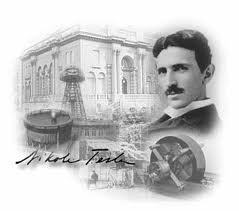
Now let's take a look at a few of the above facts that, when taken together, may paint quite a different picture of the tragedy of the Titanic:
1. J.P. Morgan owned White Star Line ships. J.P. Morgan was also the main conspirator behind the creation of the Federal reserve banking system. He was supposed to be on the ship but canceled at the last moment.
2. John Jacob Astor, along with Benjamin Guggenheim and Isa Strauss, were three very wealthy and powerful men, all of whom were vehemently against the creation of the Federal Reserve, and were quite outspoken on the matter. Morgan viewed Astor and Co. as a huge obstacle. These three men died when the Titanic -- a ship built by J.P. Morgan's White Star Line -- hit that infamous iceberg and sank.
3. J.P. Morgan and John Jacob Astor both funded Nikola Tesla, who created a way to generate an infinite amount of electrical energy. Tesla planned to allow people to access that energy for free, but Morgan squashed Tesla because he wanted to profit from energy, not give it away. Astor, Tesla's good friend, seemed to have deep pockets for Tesla. Not good for Morgan.
4. Once Astor, Guggenheim and Strauss were dead, there was no more public outcry against the Federal Reserve. It passed congress and was signed into law the following year on December 23, 1913. In addition, now Tesla's funding was wiped away, his friend in Astor gone.
You must admit, all of this is extremely interesting. Could Morgan have created this plot to kill off his biggest opponents? Did Morgan "whack" Astor because he was getting in his way on too many wealth and power-generating projects?
Admittedly, there are some holes in this interesting theory. For example:
1. Why wouldn't Morgan have simply had Astor, Guggenheim and Strauss shot? That certainly would have been easier than sinking an entire ship. Then again, then there would have been intense investigations into their murders. When multi-billionaires turn up dead, no stone is left unturned.
2. How could Morgan guarantee Astor, Guggenheim and Strauss would be on the ship? Maybe there were behind-the-scenes events, put in place by Morgan, to ensure those men would be on the ship. We'll never know.
3. Moreover, how could Morgan be sure Astor, Guggenheim and Strauss would go down with the ship and not get off onto lifeboats? Maybe Morgan knew well of the truly high character of Astor: "Colonel Astor was another of the heroes of the awful night. Effort was made to persuade him to take a place in one of the life-boats, but he emphatically refused to do so until every woman and child on board had been provided for, not excepting the women members of the ship's company [4]." Apparently, Guggenheim and Strauss did the same.
4. Why would J.P. Morgan have believed that unless Astor, Guggenheim and Strauss were killed, his coveted Federal Reserve Act wouldn't have passed? It seems strange that these three men would have had the combined political power to diffuse Morgan & Co.'s clandestine plans.
However, even with the doubt these questions raise in this theory, one cannot help but look upon the story of the Titanic with suspicion.
Is it just a coincidence that J.P. Morgan owned White Star Line, the company that produced the supposedly unsinkable Titanic, and that it went down with his enemy, John Jacob Astor, as well as Federal Reserve opposers Guggenheim and Strauss?
And is it merely coincidence that Morgan and Astor both funded Nikola Tesla, whose innovations could have been either the greatest gifts to mankind or the greatest wealth generators for the few, depending upon who controlled them?
Could the Titanic have been the most ingenious assassination in history?
ARTICLE SOURCE -- http://www.truthoffering.com
THE TITANIC INSURANCE SCAM
by John Hamer
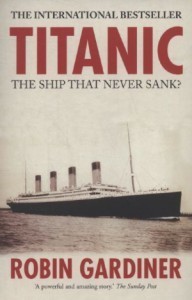 In 1908, financier J.P. Morgan planned a brand new class of luxury liners that would enable the wealthy to cross the Atlantic in previously undreamed-of opulence. The construction of the giant vessels, the 'Olympic', the 'Titanic' and the 'Britannic,' began in 1909 at the Harland and Wolff shipyard in Belfast, Ireland.
In 1908, financier J.P. Morgan planned a brand new class of luxury liners that would enable the wealthy to cross the Atlantic in previously undreamed-of opulence. The construction of the giant vessels, the 'Olympic', the 'Titanic' and the 'Britannic,' began in 1909 at the Harland and Wolff shipyard in Belfast, Ireland.
Unfortunately for Morgan and his personal bank balance, this money-making venture went a little awry. The Olympic, the first one of the three sister-ships to be completed was involved in a serious collision with the British Royal Navy cruiser, HMS Hawke in September 1911 in Southampton a few weeks after its maiden voyage and had to be 'patched-up' before returning to Belfast to undergo proper repair work.
In hindsight, it does seem strange that although the Olympic, the first of the 'sisters' to enter service, was never given the publicity her younger sister, the Titanic, enjoyed the following year Why would that be?
In the meantime a Royal Navy inquiry into the accident found the Olympic at fault for the collision and this meant that the owner, White Star Line's insurance was null and void. The White Star Line was out of pocket to the tune of at least £800,000 (around $90m today) for repairs and lost revenues.
However, for Morgan and the White Star Line, there was even worse news.
It is believed that the keel of the ship was actually twisted and therefore damaged beyond economic repair, which would have effectively meant the scrapyard. The White Star Line would have been bankrupted, given its precarious financial situation..
According to Robin Gardner's book, 'Titanic, the Ship that Never Sank?'
the seeds were sown for an audacious insurance scam - the surreptitious switching of the identities of the two ships, Olympic and Titanic.
In his well-documented work, Gardner presents a long series of credible testimonies, indisputable facts and evidence, both written and photographic, that suggest that the two ships were indeed switched with a view to staging an iceberg collision or other unknown fatal event.
According to Gardner, "Almost two months after the Hawke/Olympic collision, the reconverted Titanic, now superficially identical to her sister except for the C deck portholes, quietly left Belfast for Southampton to begin a very successful 25-year career as the Olympic. Back in the builders' yard, work progressed steadily on transforming the battered hulk of the Olympic into the Titanic. The decision to dispose of the damaged vessel would already have been taken. ... Instead of replacing the damaged section of keel, longitudinal bulkheads were installed to brace it".
How significant then in the light of this statement, that when the wreck of the Titanic was first investigated by Robert Ballard and his crew after its discovery in 1987, the first explorations of the wreckage reportedly showed (completely undocumented in the ships original blueprints) iron support structures in place which appeared to be supporting and bracing the keel.
This was never satisfactorily explained either at the time or subsequently but would certainly be significant if correct and there is absolutely no reason to believe that it is not correct, as it was reported by the puzzled Ballard himself who of course at that time knew nothing (and probably still does not even now) about the alleged switching of the two ships' identities.
--------------------------------------------------------------------------------------------------
References:
1. http://www.world-mysteries.com/doug_t...
2. http://www.titanic-whitestarships.com...
3. http://www.rense.com/general70/goodc.htm
4. http://www.logoi.com/notes/titanic/wo...
5. http://www.pacinst.com/terrorists/cha...
6. http://www.museumstuff.com/learn/topi...
7. http://www.historyonthenet.com/Titani...
8. http://hubpages.com/hub/The_Titanic_H...
9. http://www.reformation.org/nikola-tes...
10. Begich & Manning, "Angels Don't Play This HAARP" p. 12-13
11. O'Neil, "Prodigal Genius" p. 175
November 13, 2014
BREAD OF LIFE
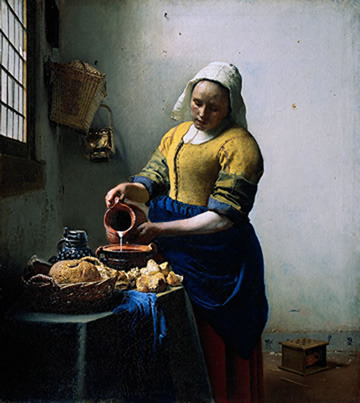 "Much like Leonardo da Vinci, I worked intermittently on this single painting over a period of many years, never satisfied that it was finished, and continually improving upon the original. This painting is my personal Mona Lisa, my daughter, Maria.
"Much like Leonardo da Vinci, I worked intermittently on this single painting over a period of many years, never satisfied that it was finished, and continually improving upon the original. This painting is my personal Mona Lisa, my daughter, Maria. We had a live-in servant for many years, named Tanneke Everpoel, hired and paid by Maria Thins. She did all of the "heavy labor", as it were: cooking, cleaning, washing clothes, carrying water, tending fires, and a myriad other chores, including helping with the children. However, the expense of paying her wage and room did not include standing for endless hours, day after day, while I painted this portrait! My daughter, Maria, was lovelier and much more readily accessible for the task of standing for this portrait.
It is argued, convincingly, that the immortal painting by Leonard was his own self-portrait as his own, feminine reflection. What man, or woman, regardless of sexual preference in a given lifetime, has not inhabited the flesh of ten thousand bodies, some human, many not, through a nearly infinite cascade of galaxies, stars and planets come and gone. Is not survival a nearly infinite game, in which we interchange ourselves as the players of many parts?
Leonardo kept his portrait with him all his life. He never considered that it was complete or perfect. Nor did he ever intend to sell it. How could one sell a most cherished reflection of himself? It is more meaningful than one's own body, which only disguises the inner self, the essence of spirit that animates the fragile flesh. In fact, a body hides the reflection of the soul! How can any substance, especially that as rude and fragile as meat, reveal the inherent qualities an immortal nothingness? Indeed, it is the fundamental challenge and the most formidable task of an artist to reveal it!
The name given to this painting by others, "The Milkmaid", is a sacrilege! It rivals the incomprehension others have for Leonardo's personal masterpiece. Yet, how can anyone truly understand that a painting is meant to reflect the essence of an immortal being, seen through the eyes of another?
She is painted with angelic colors: blue, gold and white, in contrast to the menial nature of her station in life. From her issues, for me, the Milk and Bread of Life. Life is embodied in her and through her. Women, are the source of children, the source of energy, the source of care. There is no more vital responsibility for any being who plays the game of life, than to confront dreary daily tasks. To humbly make the daily loaf. To soak that bread, mix and soften it with milk, make it warm and feed it to a teething child. Survival is made of such things.
In those days I viewed life as idyllic. My dreams were more real than reality. All things were a possibility. Tragedy could not find me. Until it did, of course. Even when we lost a child, which we did with several, my wife, Catharina, remained resolute in her Faith. God guided us. He did what was best. We knew not why and need not question His purpose for us.
I have no such faith in predetermination. A loaf of grain, clean water and a bed was my fare. Time and a place to paint, uninterrupted, were necessities. My love, shared with wife and family, was the staple diet of my life. I assumed, as a Fool who knows not his own mortality, that they would endure, even when I was gone."
_______________________________________
Excerpt from the book VERMEER: PORTRAITS OF A LIFETIME, by Lawrence R. Spencer
DOWNLOAD THIS BOOK FROM
http://itunes.apple.com/us/book/vermeer/id443800993?mt=11





